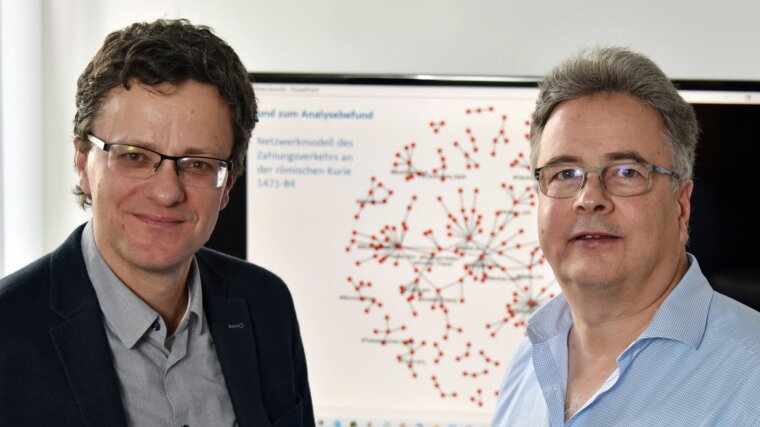
- Research
Published: | By: Sebastian Hollstein
Finding written sources, analysing them and using the results of the analysis to answer a research question - this is how historians work. For centuries, this mainly meant searching for papers and poring over books in archives and libraries, compiling card indexes and then writing down and publishing answers to research questions. Nowadays, researchers in History and other humanities disciplines are increasingly analysing digital resources for their work using computer-aided methods. As part of the new project "Research Data Infrastructure for Historical Sources" (HisQu), researchers at Friedrich Schiller University Jena are therefore developing new digital methods and infrastructures for this procedure together with colleagues from the German Historical Institute in Rome, the Göttingen Academy od Sciences and Humanities in Lower Saxony and the Gotha Research Library at the University of Erfurt. The German Research Foundation is supporting the Digital Humanities project with 1.9 million euros over the next three years – 1.1 million euros of which will go to Jena.
"We want to develop a digital research data infrastructure that makes it possible to use digital methods and processes at all levels of scientific work," explains historian apl. Prof. Dr Robert Gramsch-Stehfest from the University of Jena. "And for this we need sources that are available in digital form, as well as researchers who can evaluate them professionally and formalise the analysis process," adds Jena Computer Science Professor Clemens Beckstein.
Sources on church history
The project partners in Göttingen and Rome provide medieval sources on church history as a data basis. These are available as so-called "Regesten". These are formalised summaries of content that have been helping historians for centuries to gain an overview of certain source complexes without having to handle every single document. Although they are now mostly available in digital form, their content cannot always be processed by computer. For this reason, the researchers in the new project must first convert all texts into semantically structured data.
Creating a categorisation system
In order to semantically analyse all sources and thus distil key information, the platform needs what is known as an ontology. "We need to develop a category system that works for our subject area – i.e. church law, church administration and such items," explains Robert Gramsch-Stehfest. "Strictly speaking, we are not inventing this system, but reconstructing what has already come into play during the creation of the source collections."
With the help of such a system, historians can analyse a large number of sources simultaneously and filter out, for example, people, places, legal acts or ownership structures. For example, the contributors are analysing the monetary transactions between the Vatican and German church representatives. Thanks to the digital methods, they can filter out protagonists, conduct network analyses and take a closer look at temporal processes and geographical areas.
FactGrid as a knowledge repository
The project relies on the "FactGrid – a database for historiansExternal link" platform to record the data obtained in a structured manner and to link it with international standards and projects such as Wikidata. The database, which is based on Wikibase technology, works in a similar way to Wikipedia and enables open, collaborative work between researchers at different locations. FactGrid allows complex relationships between people, institutions, events and places to be precisely mapped. This creates dynamic knowledge networks that make historical developments more transparent.
Digital laboratory diary
"However, our focus is not on historical questions," says Clemens Beckstein. "Instead, we are concentrating on the individual methods that together form a research infrastructure. This should have a modular structure so that it can be applied to many other similar collections of sources and problems. We want to set standards on which other projects of this kind can build." Not only written sources are conceivable here, but also other collections, for example from archaeology.
It is also important to the researchers that the results obtained with the help of the digital research data infrastructure are also stored there so that other users can benefit from them. To this end, the infrastructure even documents the path to individual research results – with the help of a kind of laboratory diary. "This method has long been common practice in the natural sciences," explains Clemens Beckstein. "It helps to understand and reproduce the researchers' approach, may provide important impetus for similar problems and delivers valuable interim results."
It is no coincidence that the University of Jena is in charge of the new project. History and Computer Science have already been cooperating here for around ten years as part of the initiative "Digital Models, Declarations and Processes in the Historical Sciences" (MEPHISTO for short), integrating digital humanities into courses and implementing joint projects. "The fact that experts from these two very different disciplines can work together on an equal footing and benefit from each other is not necessarily common. There are certainly hurdles to overcome in this kind of collaboration," says Gramsch-Stehfest. "You have to develop a common language, make the other person understand your own content and procedures and sometimes also point out the limits of what is feasible," adds Beckstein.